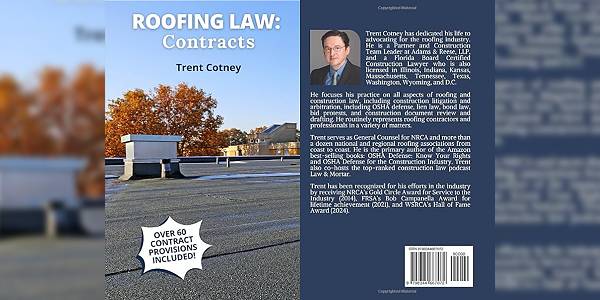Conditions to Consider When Generating a Subcontractor Agreement

By Trent Cotney, Adams & Reese LLP.
Communicating your needs is essential for a successful project.
When working on a business project, communicating is key for all parties involved. Prime contractors and subcontractors need a definitive and coherent understanding of what is to be expected from one another to maintain steady workflow. And that communication starts with the contract. Both parties must be aware of their responsibilities and liabilities, and those details lie in the contract provisions. What follows are important stipulations to consider.
Scope of work
When beginning a project, prime contractors must outline the scope of work for the subcontractors. In most cases, prime contractors tend to make the scope broader, while the subcontractors prefer it to be more specific. It is essential that the scope matches the work described in the bid proposal. If there are any exclusions, they must be noted. Without a well-defined scope, prime contractors may find that the work falls short of their expectations. Unfortunately, most disputes on construction projects arise out of a poorly defined scope of work.
Flow-through
The flow-through clause allows the prime contractor to pass along their responsibilities from the owners to the subcontractors. Although such a clause is necessary from the prime contractors’ point of view, the subcontractors may feel as though they are agreeing to something they have never read. So, it may be important to provide the subcontractor with a copy of the agreement between the owner and the prime contractor.
Indemnification
An indemnification clause requires one party to assume responsibility for damage or loss caused by the other party. The party agreeing to such responsibility is the indemnitor, and it holds the other party harmless from damage or loss. These clauses are often subject to local and state laws, so contractors and subcontractors should carefully review them. In most cases, the prime contractor should not assume responsibility beyond its and the subcontractor’s negligence. And subcontractors will likely want to avoid assuming broad form indemnity with prime contractors. It is also essential that any party agreeing to indemnity is insured at a level high enough to cover any resulting loss or damage.
Liquidated damages
Most contracts provide for liquidated damages when there are delays on a project. They usually require a prime contractor to pay specific amounts based on each day of the delay. With a flow-through clause, a subcontractor can also be held responsible. If the clause is well written, it can protect the prime contractor from unexpected expenses. And both parties should ensure that the liquidated damages clause limits their exposure.
No damages for delay
In most cases, if an owner causes a delay on a construction project, the prime contractor and subcontractor can recover damages. However, when a no-damages-for-delay clause is included in the contract, the prime contractor cannot recover damages, and per a flow-through clause, neither can the subcontractor. Instead, they are usually given more time to complete the project. Both prime contractors and subcontractors may object to the no-damages-for-delay clause since any scheduling issues may take time away from future projects they have planned.
Termination for convenience
This clause allows an owner or prime contractor to cancel a contract or subcontract without cause and for any reason. Such a termination can have a substantial financial impact on both contractors and subcontractors. Therefore, they should try to include language that guarantees they will be paid for work completed prior to the termination. Subcontractors may also request that a contractor is allowed to terminate for convenience only if the owner has done so.
Termination for default
This type of termination usually occurs downstream when an owner or prime contractor cancels a contract due to breach. Causes include a failure to perform, follow laws and ordinances, and fix subpar work. Both contractors and subcontractors should ensure that the contract allows for sufficient notice and opportunity to cure before such termination. Otherwise, they could face serious financial implications. They could also be held responsible for consequential damages, such as lost rent, lost profits, loss of use and damage to reputation.
Dispute resolution
Quite often, if one party files a claim against another, the matter ends up in court. However, many contracts include an arbitration provision. This stipulation requires that all parties agree to participate in arbitration to resolve the dispute. While the arbitration process is much faster than litigation, it can also be more expensive. In addition, all parties must understand that the arbiter’s decision is final and appeal of that decision is difficult. Therefore, it is critical that both prime contractors and subcontractors carefully review any language regarding disputes and arbitration. The contract should expressly state which parties are responsible for covering expenses.
Final thoughts
When prime contractors and subcontractors enter an agreement, it is essential that they understand one another’s expectations. All those details should be outlined in the contract.
If you are entering such an agreement and are unsure what provisions should be included in your contract, do not hesitate to consult legal counsel. An experienced construction attorney can review your contract and advise you about protecting the contractor-subcontractor working relationship.
About Trent Cotney
Trent Cotney is a partner and Construction Practice Group Leader at the law firm of Adams and Reese LLP and NRCA General Counsel. For more information, reach out to Trent at trent.cotney@arlaw.com.
The information contained in this article is for general educational information only. This information does not constitute legal advice, is not intended to constitute legal advice, nor should it be relied upon as legal advice for your specific factual pattern or situation.























Comments
Leave a Reply
Have an account? Login to leave a comment!
Sign In